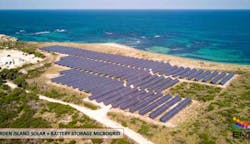Giles Parkinson of Renew Economy describes operational problems faced by a microgrid installed by Carnegie Clean Energy at an Australian naval base.
The Garden Island microgrid, located in a naval base off the port of Fremantle south of Perth, was supposed to be a shining light for the future of distributed energy, and potentially the world’s first micro-grid incorporating wave energy. But so far it hasn’t turned out that well.
Carnegie Clean Energy reveals in its latest annual report that the microgrid — which features a 2 MW solar array and and 2 MW/0.5 MWh of battery storage and which began operations in August, 2019 — had been plagued by “teething issues and panel failures” in its first few months that meant it wasn’t able to operate at full capacity.
And then, in early April, the plant was disconnected due to major infrastructure changes on the Naval Base. This, Carnegie says, had been expected, but out of its control. It is hopeful that it will be re-connected shortly, by which time it hopes to have resolved its technical issues.
However, the experience has been costly. Carnegie suffered an impairment of $4.7 million relating to the Garden Island microgrid in last-year’s accounts, and it is clear that revenues from the operation were below expectation this year.
The Department of Defense is spending $350 million upgrading the facilities at Garden Island and the HMAS Stirling naval base it houses, including an upgrade of the electrical system.
“Carnegie anticipates that the system should be reconnected in the current quarter, however this is subject to progress on Defense’s upgrades and is largely outside Carnegie’s control,” it says in its annual report.
“The net of costs and lost revenue associated with the reconnection process is so far consistent with expectations. Once completed, Defense’s upgraded electrical system will support morestreamlined operations of the Garden Island Microgrid.”
Garden Island is actually the main revenue earner for Carnegie, which is still chasing its dream of creating commercially viable wave energy machines, even if it had to go back to the drawing board after losing a promised grant from the W.A. government and ARENA last year.
It is now working on “wave predictor” technologies and smart controls, before seeking to rollout the latest version of its CETO technology that it still hopes can be deployed in places such as remote islands, near Garden Island, or perhaps near Albany off the south coast of W.A.
Giles Parkinson is founder and editor of Renew Economy, where this post originally appeared. The article was reposted with permission.







